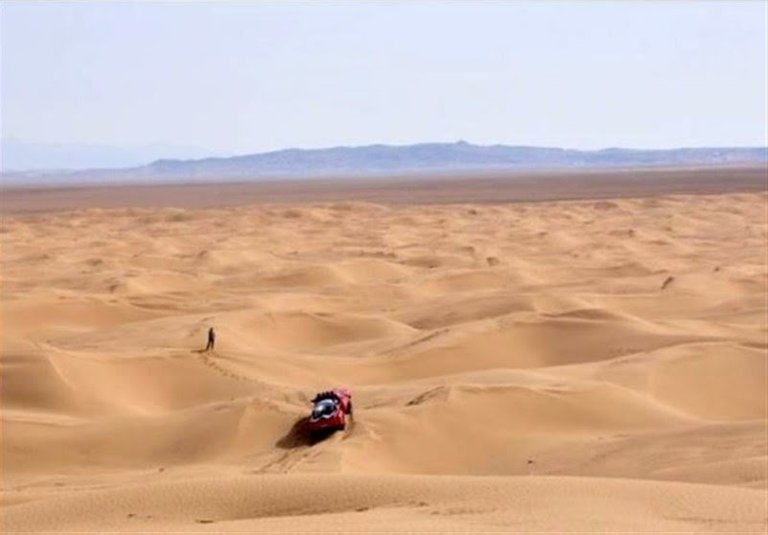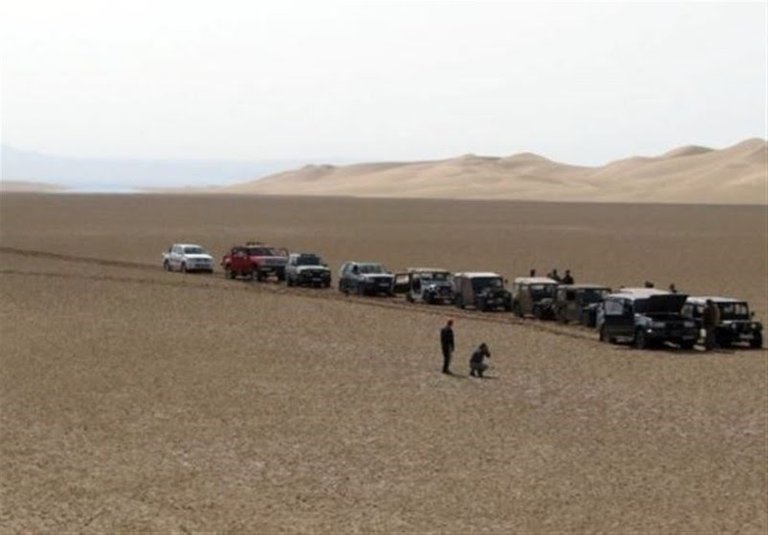
Information from the site
https://www.tasnimnews.com
According to the Tasnim news agency from Semnan , there are no signs of life in this area at present. This desert is located in the southwest and west of Kavir plain, south of Semnan, southeast of Garmsar, east of Kavir protected area, north of Anarak and west of Jandagh and has an area of 3800 square kilometers.
There are no springs or water wells in this area. Most of the maps do not mention this area. Only two European desertologists have mentioned the existence of such a desert in Iran in their travelogues in the past.
Righ Jan is the most amazing, mysterious and scary region of Iran, with terrible swamps that bring death to any living thing. Many unanswered and unjustified incidents have taken place in this region, and the salt marshes of this region have been the place of killing and burying many living beings.
The foundation of Righ Jan is an eroded plain, which is currently occupied by the sand dunes of Barkhan and the pyramidal sand dunes (Qord). All sandstones have abundant salt sediments, most of which are sediments and erosive materials formed from the eroded slopes of Alborz.
Drowning in mud and silt in "Righ Jan" is perhaps one of the most dangerous events that can befall passengers and lead them to death. For many years, no one dared to travel to "Rig Jan" and discover the secret of this mysterious desert, or even if he did, he would leave because of his unfamiliarity with the region
Information from the site
https://www.tasnimnews.com

.
Sonhuddin discovered Rgen in 1900, and Alfonso Gabriel later passed by in 1930; But none of them could cross this part of the desert and had to return to Yazd; But crossing it remained a dream for deserters until, in 1997, the Rigogen spell was finally broken by Ali Parsa, an American desertologist. He and Mr. Miranzadeh, the then head of the Kavir National Park, flew over the sand dune to prove that there was nothing surprising in the sand dune. Ali Parsa, however, entered "Rig Jan" by car a year later, and after that, many desert climbers passed through "Rig Jan". Of course, with complete equipment that neither captured the soul nor the corpse!
The word jinn means hidden and hidden, jinns are named jinns (invisible) because they are hidden from public view, because they were hidden from human eyes and could not be seen. This meaning is hidden in all derivatives of the word jinn, for example, the heart and soul are called "jinn" because it is hidden.
Paradise is called "Paradise" because it is hidden from our sight, and the shield is called "Paradise" because a person hides behind it during war. "Fetus" is called the baby in the womb, because the baby is hidden in the mother's womb, and "jinn" is also called the jinn because it is hidden from our eyes.
The lack of water resources in the vast expanse of sand dunes, along with the presence of natural barriers such as salt marshes and high sand dunes, have been factors that have kept the area out of human reach for centuries.
These factors have caused this vast field to be hidden from human beings throughout history, and as a result, they named it after jinn. Ambiguous folk tales and stories about Righ Jan have generally originated from the inability of slum dwellers or travelers to cross the area. The presence of a lot of heat in this region, considering that in the Qur'an the genus is made of heat and fire, has probably not been ineffective in choosing this name.
Also, the fact that the southern parts of the sand dune are covered with sand dunes and the sound that the wind moves on these hills is definitely one of the factors influencing the public belief in the existence of metaphysical powers in this region.
The large difference in temperature between night and day and the crushing of rocks due to this huge difference, which is known as "rock crying", has also been attributed to the same metaphysical factors.
Geographic Area
There is no clear boundary for the elf sand. Briefly, this region is located in the geographical area of central Iran in the western part of the central desert or desert plain and from the north to Semnan military road to teachers, the heights of Sulfur Mountain, Garmsar city, from the west to the desert national park, Nakhjir heights, Talha mountain, The devil of the mountain, the mountain of tail and darkness, is limited from the east to the axis of communication between Jandagh to teachers and from the south to the axis of Anarak to the shepherds and Mount Malahadi (the big mountain). Righ Jan extends from northwest to southeast and has an area of about 90,000 square kilometers.
The genie sand spreads from northeast to southwest. This area leads to Sulfur Mountain and Moallem area in the northeast, to Anarak in the south, to Jandagh area in the east and to Kavir National Park from the west.
The most important thing is that if you have not yet climbed the desert and you are not a so-called professional, do not choose the name Rig Jan for the first experience, in which case you are going with yourself and returning with God, even if you are a professional, be sure to travel to this area. The best way to travel to the desert is light jeeps, do not forget the map.
If you have GPS (a device for recording geographical points and is actually a satellite electronic guide), what is better, and since traveling to the sand dune is a new and very difficult move and as a result an accurate map is not available, you can use GPS and point recording, Check the accuracy of your drawings. Not only for traveling to Righ Jan, but to travel to any part of the desert fully equipped and without the slightest shortcomings and doubts.
To travel to Righ Jan, you must have at least two weeks of water, gasoline, food and technical equipment of the car. Also, do not forget the locals, locals are usually experienced people and in addition to directing the route, even in difficult situations, they can guide you very well.
If you go from Jandagh to Righ Jan, after a winding path, you will enter a dry and wide river, after crossing the river, it works to the eye. It is mountains and sand dunes. Part of the area is relatively flat and the hills are smaller, so it seems relatively easy to cross, but with a slight advance as the altitude decreases, you will reach swampy lands, which is almost south of the area.
The urge to cross these swamps is useless, so it is best to keep moving from the northwest. The last mountains, which are 2300 meters high, reach the northern part of Rig Jan. From here, you can also see Damavand Mountain. By continuing this route, you will reach Kavir National Park. Of course, after crossing the dry Nakhjir River and Kavir National Park, it is the end point that takes you to Malekabad Varamin and Tehran checkpoints, and so far you have traveled more than a thousand kilometers in the desert.
Of course, this route is one of the proposed routes that many groups have crossed so far. If you like another route, you can try a new route using the map and guide; But all these hardships and ups and downs are one-sided and the starry night sky is one-sided.
Sleeping on quicksand on high hills and gazing at the sky that does not have a single black dot, and meteors that occasionally, like the arrows of the guardian angels that keep demons from approaching the earth, relieve all daily fatigue and sinking into the sand and swamp. .
The Legends of the Sandstones
The suburbs and locals of this area, the shepherds and the herdsmen believe that if someone reaches the sand of the jinn, he immediately disappears and is sent to the heart of the sand by the spirits and supernatural beings! One of the explorers says that even the camels of the desert stand when they reach this area and do not move at all!
The movement of sand dunes and their deformation were also known due to the presence of evil powers in this area. What is clear is that most of the sand dunes are constantly changing due to the lack of vegetation due to the lack of vegetation.
In the book Deserts of Iran, Hedin narrates a legend from the people of that time that there is a lost paradise in the center of the sand. There is a lake in this paradise and there are dense forests next to it. The demons have left the camels' wool there, and whoever reaches this area will become rich. Of course, there is neither a lake nor a forest in the center of the sand. What is there are puffy clay soils that are unable to grow due to the intensity of evaporation and salinity.
What is true about the jinn is the miserliness of heaven and the wrath of the earth, which has turned it into a land of legends. What should be considered when traveling to such areas is to pay attention to technical points, safety and having enough experience. Despite its calm and patient appearance, the desert has a harsh and dangerous nature. Travel to such areas requires special arrangements, and without the necessary studies, it will certainly have dire consequences.